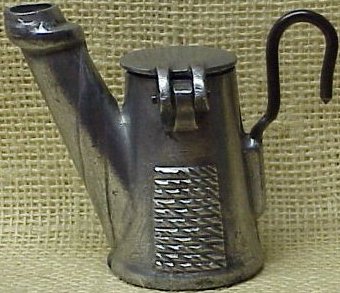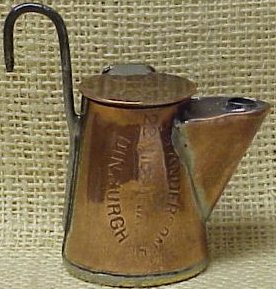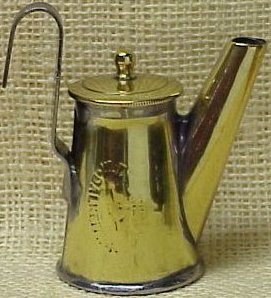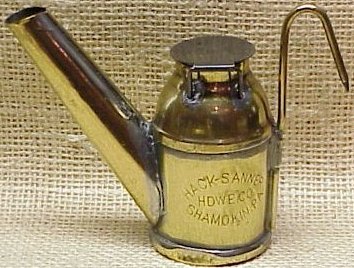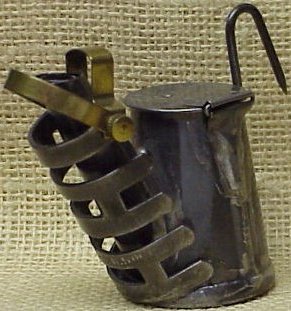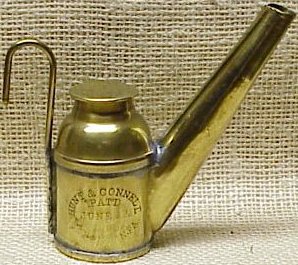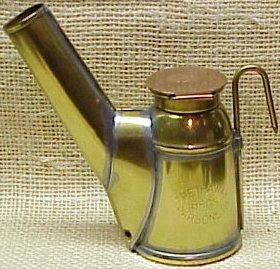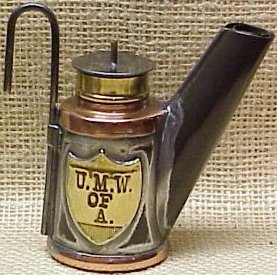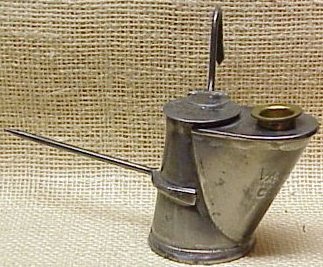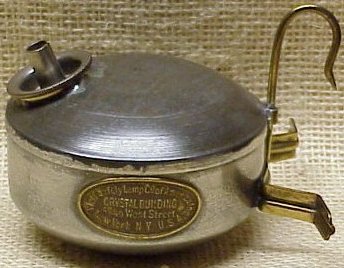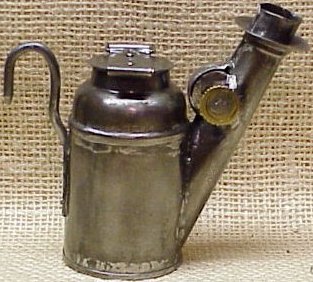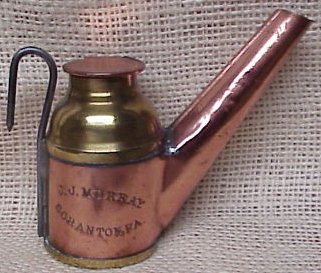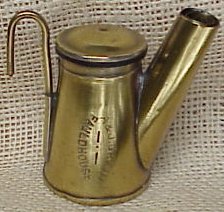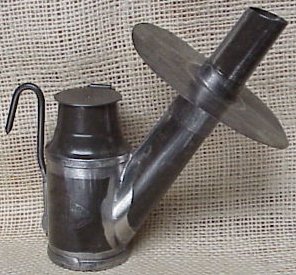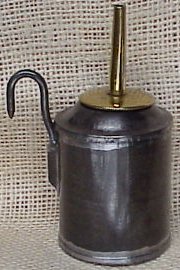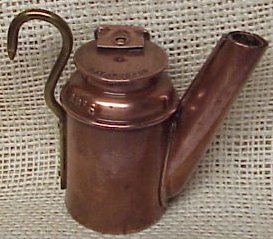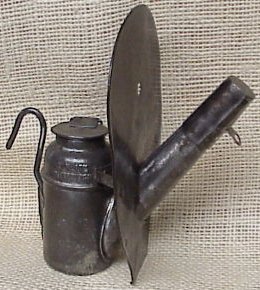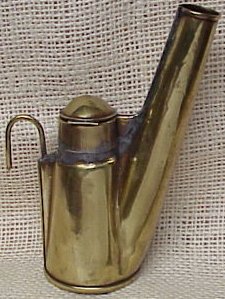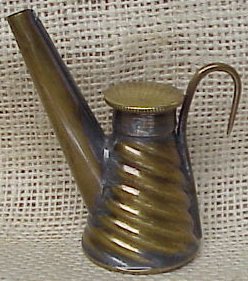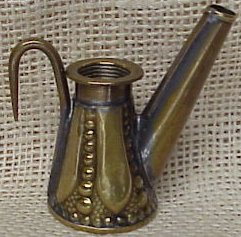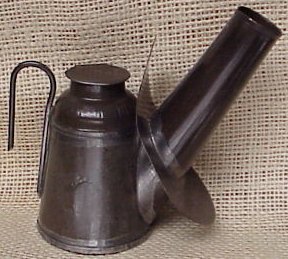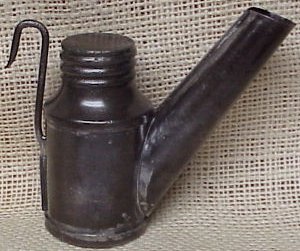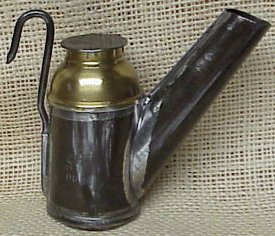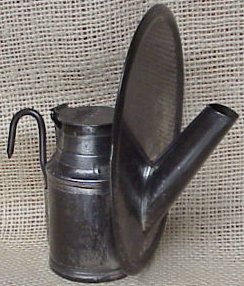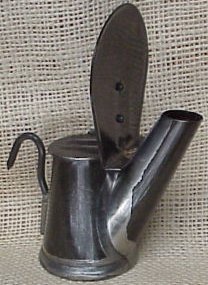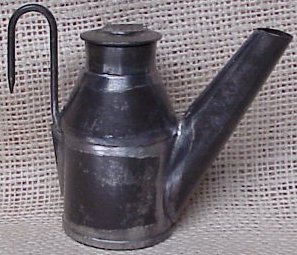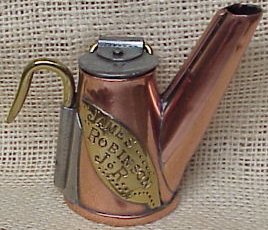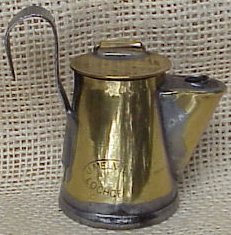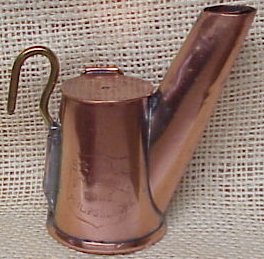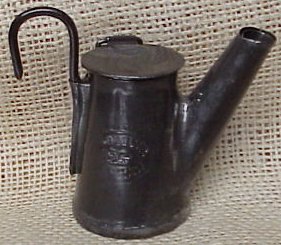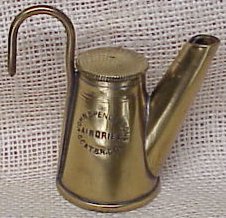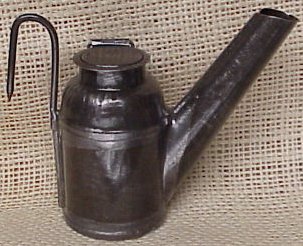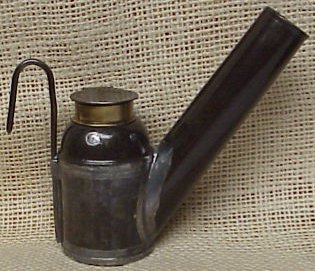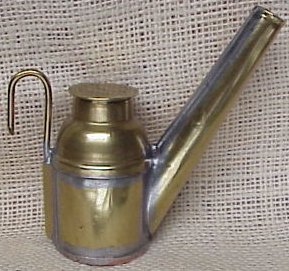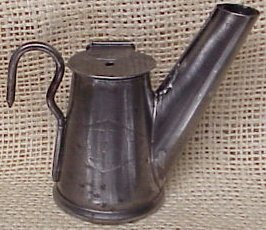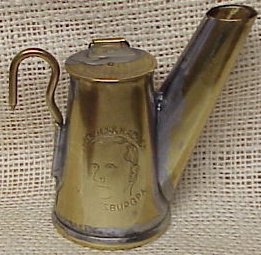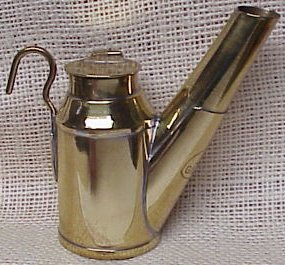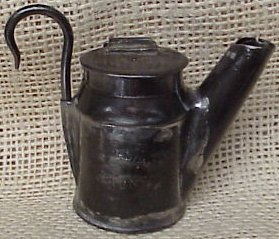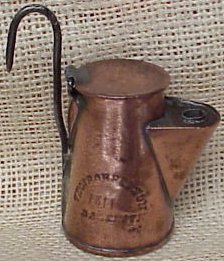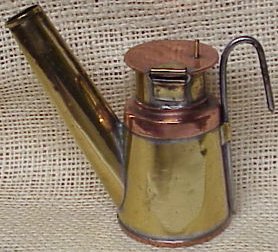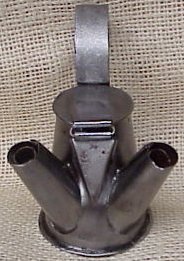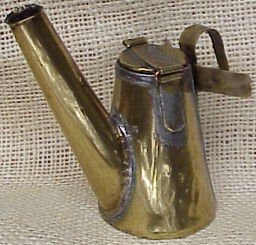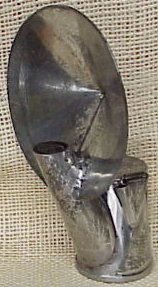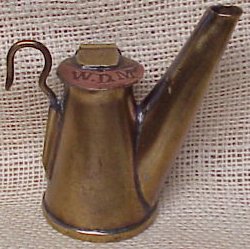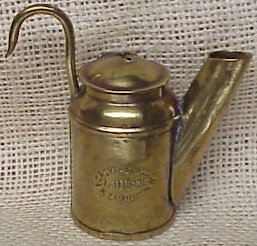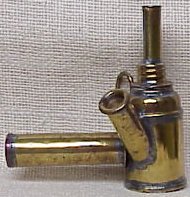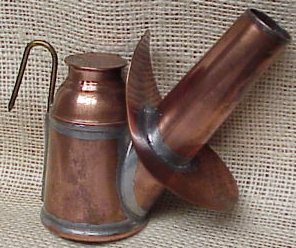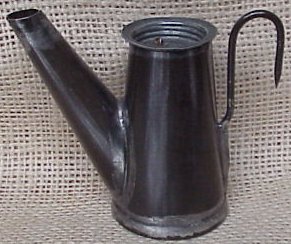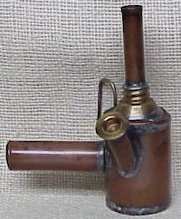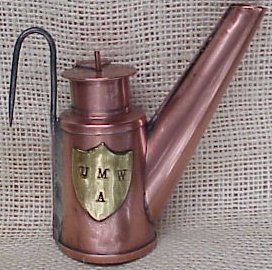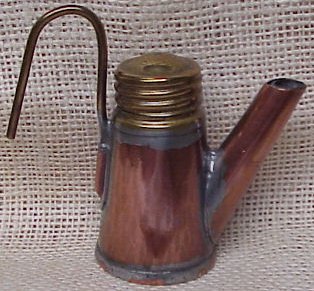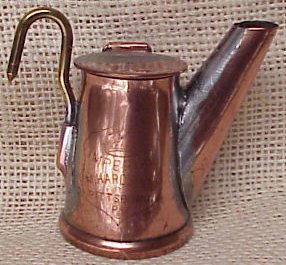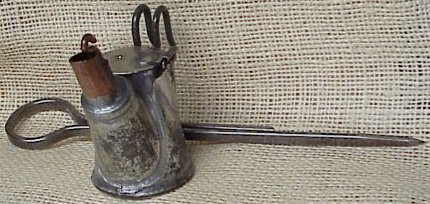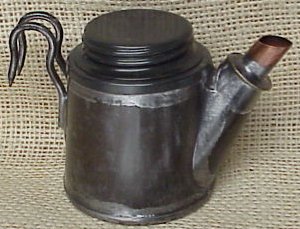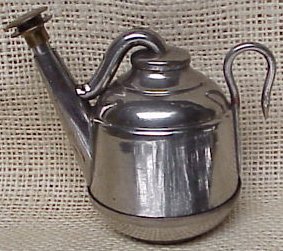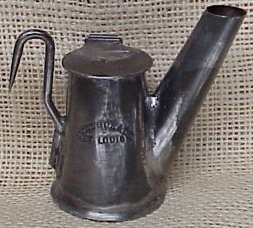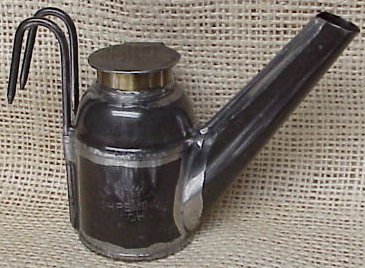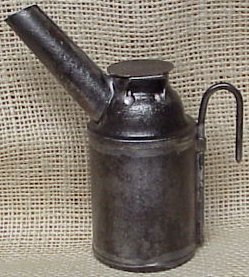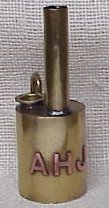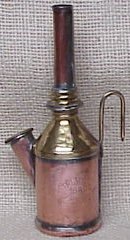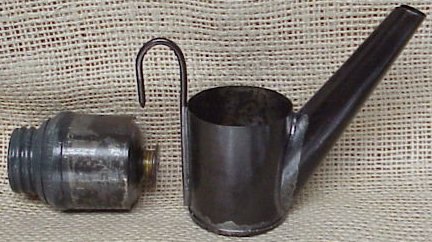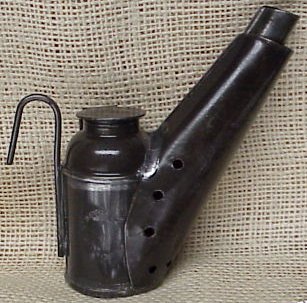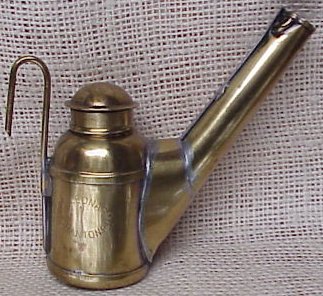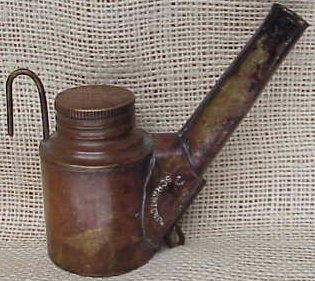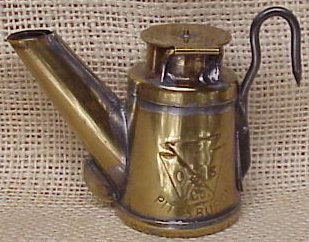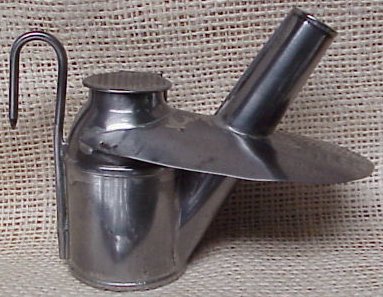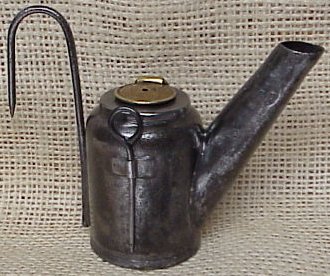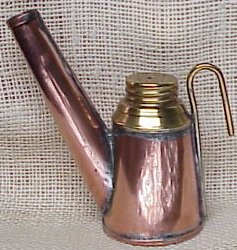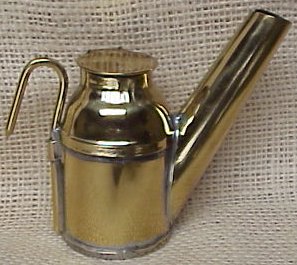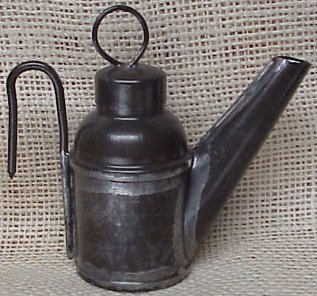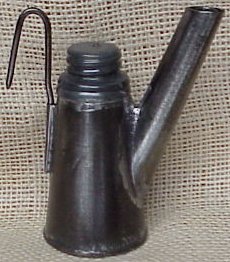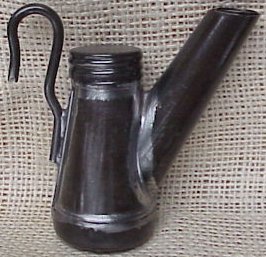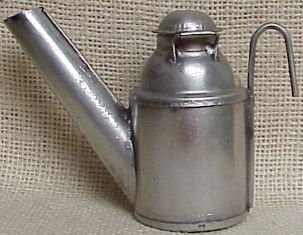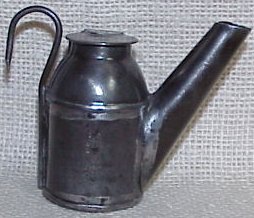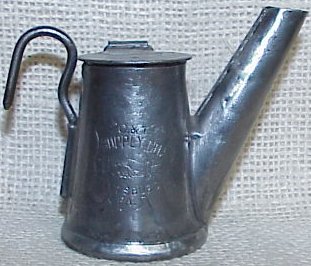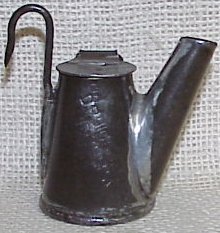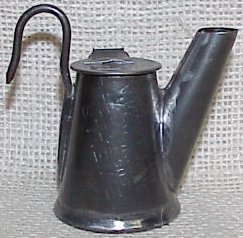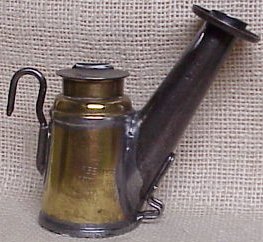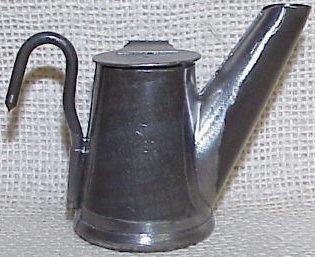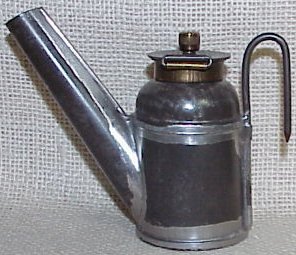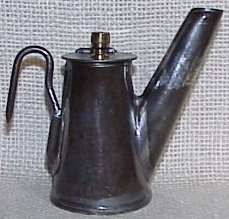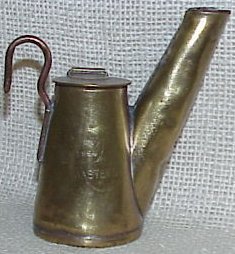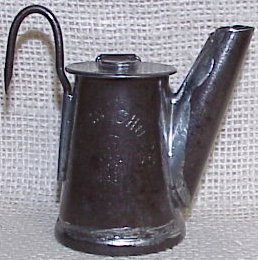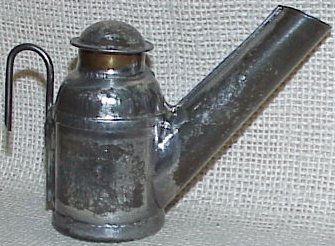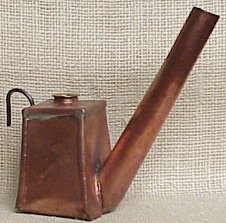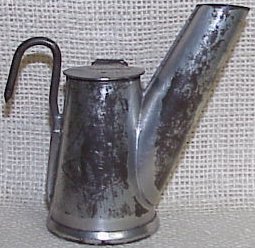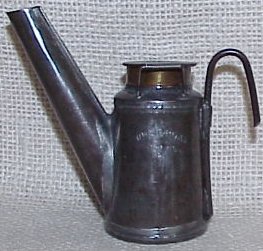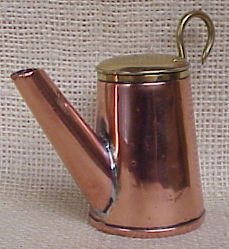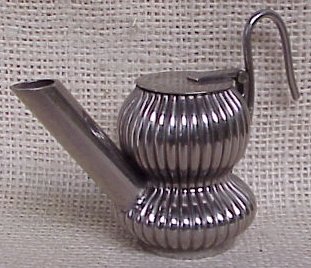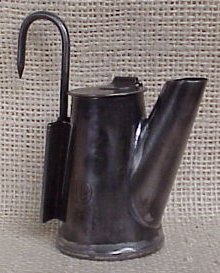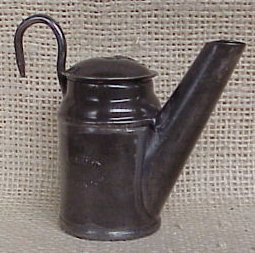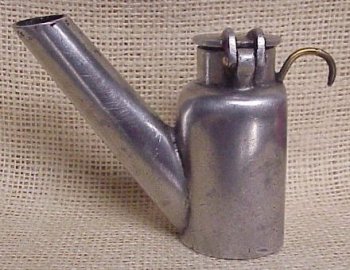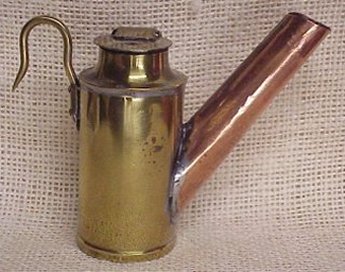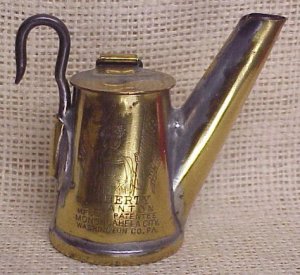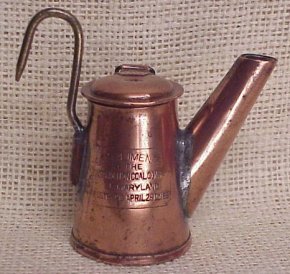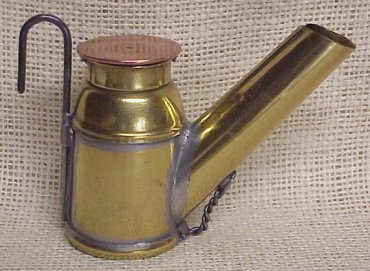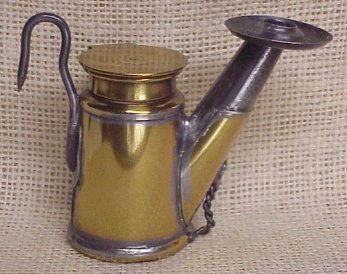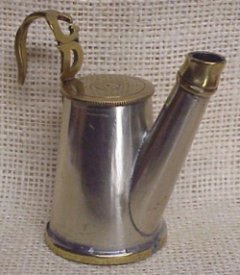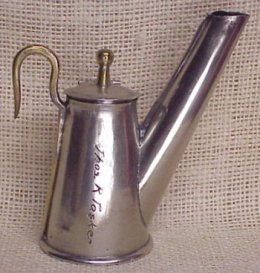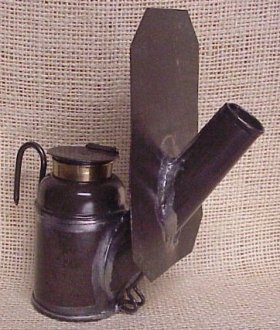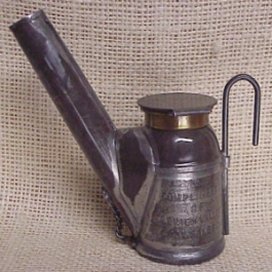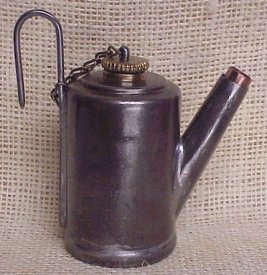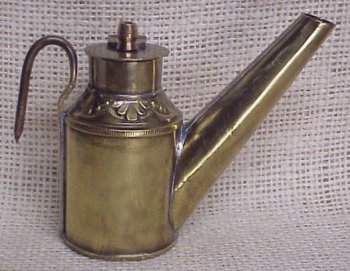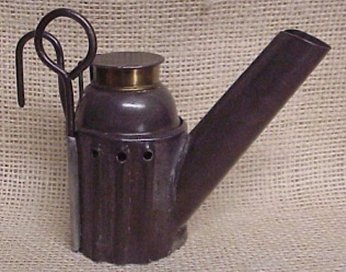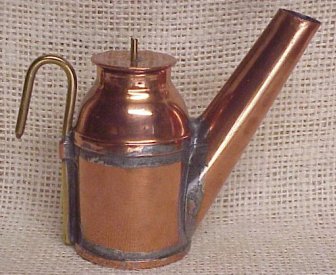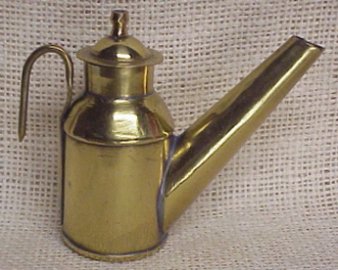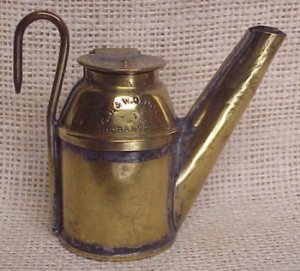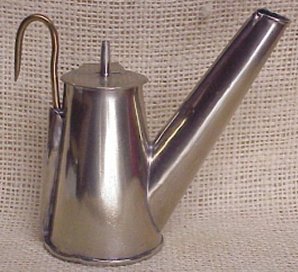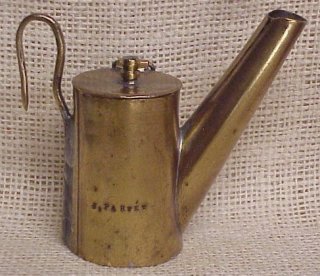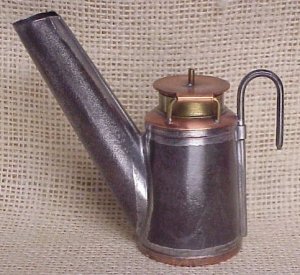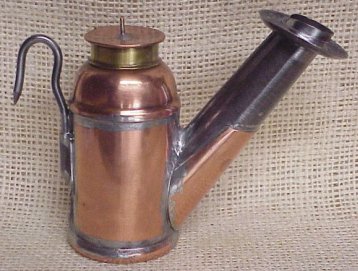MINERS' OIL WICK CAP LAMPS
Cast Aluminum with Match Striker.
J.H. Anderson - Edinburgh Scotland
Rollins Patent made by Hunt & Connell
Trethaway Bros.
Harrison Patent Lamp
W. Falconer & Son - Dalkeith Scotland
Trethaway Bros. - Parsons, PA
Trethaway Bros.
Vacuum Oil Co.
Rudolf Zicha - Cleveland, Ohio
Wolf Safety Lamp Co.
Bishop Bros. - Archbald, PA
J.J. Murray
Copper Dunlap Pat. Apld. For
A. & J. Grant - Fauldhouse
Presentation Lamp
Presentation Lamp
Initialed Brass & Copper Lamp
Shielded Dunlap with Spout Cover
E.F. Long Patent Lamp
F.E. Spry
Hardsocg Imperial Lamp with Weaver & Hough Patented Shield
Unmarked Shielded Lamp
Carbon Lamp
Shielded Grier Bros. Lamp
Forsyth & Caldow - Stepside Kilmarnock Scotland
James S. Robinson
J. Melville - Lochgelly Scotland.
Sheet M.S. & Mach. Co. - Pittsburg, PA
John D. Gills Sons - Phillipsburg, PA
Koch Patent Lamp made by Wm.Tunnessen
The Gill Lamp
Lee Bros. - Plymouth, PA
L.B. Potter & Co. - Scranton, PA
Brass Lamp with Cap Brace
Twin Spout Lamp - England
Trethaway Bros. - Parsons, PA
Magic City Lamp
John Spence & Sons Airdrie & Coatbridge
Thomas Hall - Irvine Scotland
Grier Bros. - Pittsburgh, PA
Fred B. Zais - Frostburg, MD
John Muir Lamp - Scotland
Hoover Bros.
Perfection Lamp with J.R. Watts Patent Wick Raiser
Shielded Beall Bros..
Husson Lamp Knippenberg Mfg. Co. with Removable Stick
M.M. Buck - St. Louis.
Unmarked
Unmarked
Vertical Spout.
Unmarked
F. Sturges & Co. - Chicago
Trethaway Bros.
Unmarked
T.F. Leonard - Scranton, PA
Bertels
Unmarked
Miners Supply Co. - St. Clair, PA
Highspout Trethaway Bros..
T.F. Leonard - Scranton, PA
Davis & Magee Patent Lamp with removable Font Insert
Keystone Oil Supply Co. made by Trethaway Bros.
J.D. Williams Patent Lamp with Spout Cover
I.E. Swift Co. - Ishpeming, MI
Shielded Copper Trethaway Bros.
Husson No. 3 Knippenberg Mfg. Co. - Oshkosh, WI
Winfield Patent Lamp
W.B. Bertels Lamp
Trethaway Bros.
M. Hardsocg Imperial Lamp
Crown - Wm. Tunnessen
D.D. Williams Patent Lamp
Miners' oil wick cap lamps were used in the U.S. from the 1860s into the early 1920s in some areas with the first patent for a miners' oil wick lamp being granted to Wm. Seybold on May 13, 1862 and the last patent being granted to William Huuskanen on December 4, 1917. Of the 119 oil wick cap lamp patents awarded 70 were granted in the state of Pennsylvania with the remainder being divided among 14 other states. The lamps with single wall spouts were designed to burn a liquid fuel while those with double wall spouts were designed to burn liquid fuel or a paraffin based solid fuel sold under the brand name "Sunshine".
Aluminum Trethaway Bros.
Fred Beiter - Pittsburgh
C&T Supply Co.
Pittsburgh
Bishop Bros.
Archbald, PA
D.P. Highberger
Irwin, PA
E.Wells
Successor to D.P. Highberger
M.& M. Progressive Co.
Pana, IL
M&O
William Morgan
Mahanoy City, PA
The Highberger
P.F. Lennon - Scranton, PA
Unmarked Copper with Square Font
M&O
Miner's Choice
McMasters
Unmarked Copper & Brass- Scotland
Lamb & Dunn - Scotland
A. Caldow - Kilmarnock Scotland
Unmarked German Silver Presentation Lamp
Thomas Robertson - Dalkeith Scotland
McClave Patent Lamp
Indestructible - American Safety Lamp & Mine Supply Co.
Partial stamping - Valve Co. Chicago
C.L. Anton Liberty
Monongahela City, Washington Co. PA
Consolidation Coal Co. Frostburg, Maryland
Trethaway Bros. Parsons, PA
Trethaway Bros. Parsons, PA
Thomas R. Tasker - German Silver
G.D. initials in hook
German Silver & Brass
Unmarked
Lehigh Valley Coal Co.
Fancy Engraved Shoulder
H.J. Richards Patent
Trethaway Bros. Parsons, PA
Unmarked
C.H. & W.G. Dowd Scranton, PA
Unmarked German Silver
Trethaway Bros. Parsons, PA
J. Parfet
Shielded C. George
Trethaway Bros. Parsons, PA
Gardner & Richards "Little Gem"
Young's Patent "Miners' or Getters' Lamp
J. Anderson - Dalkeith
Wm. Nicol - Methil
D.B. Rankin - Airdrie
A. Roth & Son
W. Falconer & Son - Dalkeith
P. Roy Co. - Airdrie
Thompson & Co. - New Glasgow, N.S.
Hazleton Mach. & Supply Co. - Hazleton, PA
Anson's Lamp - John Dunlap Co.
U.S. Tool Co. - Vincennes, IN
T.R. Jones - Wilkes-Barre, PA
W. Falconer & Son - Dalkeith
Grier Bros.
A. & J. Grant - Fauldhouse
Demmler Bros. Pittsburgh, PA
What Cheer Tool Co. - What Cheer, IA
Felix Lamp - Shamokin, PA
Hardsocg Mfg. Co. - Ottumwa, IA
Hoover Bros. - Ashland, PA
J.W. Patten - Wilkes-Barre, PA
James MacCuish - Bridgeport, MI
John Mears - Philadelphia, PA
Nail City - Greer & Laing - Wheeling, WV
McD - Scotland
Perfect Sunshine Lamp
Royal H.F. & Co.
R. Ritchie - Leslie, Scotland
Patent Apld. For Removable Burner Lamp
Grant Patent with Removable Burner
Saginaw Lamp - Jennison Hdwe. Co. - Bay City, MI
Saginaw Lamp - Jennison Hdwe. Co.- Bay City, MI
The Boss
V.L. Smokeless Lamp
Unmarked
Unmarked
V.L. Smokeless Lamp
Wm. Waddell - Wishaw, N.B.
J. Engleby
J. Vogle
B.E. Leonard - Scranton, PA
Grier Bros. - Pittsburgh, PA
Grier Bros. - Pittsburgh, PA
Husson No.12 - Knippenberg Mfg. Co.
Husson No.20 - Knippenberg Mfg. Co.
Leonard Bros. Scranton, PA
Unmarked
T.F. Leonard - Scranton, PA
P.F. Lennon - Scranton PA
Unmarked
Unmarked
P.F. Lennon - Scranton PA
Oliver McDonald
Leonard Bros. Scranton, PA
Barnet & Morton
A. Glass - Dalkeith
John W. Doic
R. Grant - Portobello
F. Johnson - Frostburg
Seybold
C. George - Hazleton, PA
Fred Beiter
J.A. Williams & Co. - Pittsburgh, PA
H.J. Richards Patent
Lafferty - Irwin, PA
No Melt
Unmarked
Unmarked
E.F. Long
The Gill Lamp - John D. Gill
John D. Gills Sons - Phillipsburg, PA
Wm. Isaac
R.B. Wardin
Unmarked
Unmarked
Unmarked
Husson No.6 - Knippenberg Mfg. Co. Oshkosh, WI
Husson No.3 - Knippenberg Mfg. Co. Oshkosh, WI
Husson No.2 - Knippenberg Mfg. Co. Oshkosh, WI
Husson No.2 - Knippenberg Mfg. Co. Oshkosh, WI
Unmarked
E. B. Prichard & Co. - Frostburg, MD
J. J. Murray - Scranton, PA
R.B. Wardin
R.B. Wardin
Quinn Bros. - Scranton, PA
Eskew, Smith & Cannon - Charleston, WV
Rollins Patent - Hunt & Connell
Alex E. Hunt
The oil wick cap lamps shown above are just some of the more than 725 different oil wick cap lamps in my collection. The lamps listed below are the named and/or patented lamps in my collection. Many types and styles of lamp have the same name as many manufacturers made more than a single lamp model. Many oil wick lamps have no markings so unless the same lamp is found marked or it follows a patent design it is difficult to identify them.
ABK – marked ABK on the font.
AMERICAN MINING TOOL CO - marked AMERICAN MINING TOOL CO. OTTUMWA IOWA in a diamond on font. The American Mining Tool Co. is an uncommon brand mark. Although they had a large product line of mining tools and supplies including clothing, they are overshadowed by the much larger Hardsocg Co. which was also located in Ottumwa, Iowa. The American Mining Tool Co. was formed in 1906 with F.W. Simmons as president. The firm occupied several brick buildings on nearly 4 1/2 acres near the Burlington and Rock Island Railroad tracks in Ottumwa. They continued to manufacture a variety of mining supplies and provided equipment repair using their machine and forging shops for other local companies. In 1942, the company ceased all operations and went out of business.
J. ANDERSON - marked J. ANDERSON DALKEITH on the font.
J. H. ANDERSON - marked J.H. ANDERSON 22 VICTORIA ST. EDINBURGH on the font.
CHRISTOPHER ANTON PATENT DATE SPOUT - marked on spout PATENTED JULY 23-1901. Patent. No. 678,852 was issued to C.L. Anton on July 23, 1901 for a new spout joint design. Christopher was one of the Anton family well-known for their many lamps.
J. ANTON U.S.A. EAGLE - stamped in the eagle shield on the font U.S.A. EAGLE, TRADE MARK, J. ANTON & SON, MONONGAHELA, PA. and stamped PAT. MAR. 29, 04 on spout (patent No. 756,151). In 1874, brothers George, John and Christopher each set up workshops to manufacture wick lamps for local PA coal miners. Later George and John combined their operations and marketed their lamps worldwide under the George Anton name; the Geo. Anton STAR brand lamp, first sold in 1898, was the best selling wick lamp of its time due to the quality construction and attractive logo. In 1905, George Anton withdrew from the business and the name was changed to J. Anton and Son. The son, named George T. Anton, took over the business when his father retired and changed its name to Geo. T. Anton and Bros. Carbide lamps had steadily replaced wick lamps and in 1918, the Anton business in oil wick lamps closed. Other Anton patents - No. 229,351, No. 431,733, No. 431,734, No. 538,031, No. 764,700.
.
B ELECTRIC - marked B ELECTRIC on the font.
B FROSTBURG - marked B FROSTBURG on the font.
BARNET & MORTON - marked BARNET & MORTON on the lid, LD REGISTERED TRADEMARK on the font.
BEALL BROS. - marked BEALL BROS. ALTON, ILLS. and Maltese cross in oval football shape. In 1872, Edmond Beall joined with his brother Charles to start a firm in Alton, IL, named Beall Brothers, to manufacture mining tools. With continued expansion of the company, Beall Brothers Mining Tool Company was incorporated in 1900 with Charles Beall as president. In 1904, following continued business expansion, Charles Beall started his own company C. L. Beall Manufacturing Co. in East Alton producing a variety of tools. The next year, all the Beall interests were consolidated into Beall Bros. Inc. This company was sold in 1917 but the Beall brothers continued to start and consolidate companies that continued to manufacture shovels, mining and railroad tools, and automobile accessories. The Beall Tool Co. ceased manufacturing operations of mining tools in 1928.
F. BEITER - marked F. BEITER PITTBURG, PA on the font. These lamps were both CROWN and non-CROWN trademark.
FRED BEITER – marked FRED BEITER PITTSBURG, PA. PAT. APD. FOR on the font.
W.B. BERTELS - marked W. B. BERTELS WILKES-BARRE, PA on the font. William B. Bertels was a maker of tinware in Wilkes-Barre, PA in business as early as 1873, according to the City Directory. By 1890, the firm was named W.B. Bertels & Sons, Inc. and produced wick lamps, caps, lunch buckets, cadgers and other tinware items, such as peanut butter and lard tins. In 1910, Bertels brought suit against William Trethaway for infringement on a patent issued Oct. 24, 1905. Sebastian Spering Kresge(S.S. Kresge) was once a travelling salesman for Bertels. Although an uncommon mark, at least ten different models of Bertels lamps are known. I also have the lamps marked W.B. BERTELS MAN’F’R WILKES-BARRE, PA. and BLACK DIAMOND MINE LAMP W.B. BERTELS & SONS CO. WILKES-BARRE, PA.
J. BICKET - marked J. BICKET KILM. on the font.
BISHOP BROS. - marked BISHOP BROS. ARCHBALD, PA on the font.
THOMAS BLACK - Thomas Black of Shamokin, PA was issued patent No. 944,171 on Dec. 21, 1909 for a coiled breather tube to prevent the spillage of oil through the breather. This patent was used on a lamp manufactured by TRETHAWAY BROS.
BLACK DIAMOND - marked BLACK DIAMOND MINE LAMP WILLKES-BARRE, PA on the font. I also have a lamp marked just BLACK DIAMOND and another marked HARDSOCG’S BLACK DIAMOND.
BLUEFIELD HARDWARE CO. - marked BLUEFIELD HARDWARE CO. on the font. This is a private label lamp made by Trethaway Bros.
M.M. BUCK & CO. – marked M.M. BUCK & CO. ST. LOUIS on the font. The 1866 St. Louis City Directory lists M.M. Buck as a lamp manufacturer. The 1869 and 1870 City Directory listed M.M. Buck as a wholesaler of railroad supplies and a manufacturer of headlights and lanterns. In 1895, Alexander H. Handlan bought out Myron Buck and renamed the firm the M.M. Buck Manufacturing Co.. In, 1901, Handlan changed the firm's name to the Handlan-Buck Manufacturing Co. to produce Handlan-Buck miners’ safety lamps and a variety of railroad lamps, mill and foundry supplies.
A. CALDOW – marked A. CALDOW KILMARNOCK on the font.
CENTRAL SUPPLY CO. – marked CENTRAL SUPPLY CO. CAMBRIA PATTON, PA. This is a private label lamp under the CROWN trademark.
C. CHERRY. - This lamp carries no name but has a logo consisting of two cherries on a stem. C. Cherry sold his business, but not the rights to the Cherry trademark, to Demmler Bros..
CHIRRY - CHIRRY stamped side-by-side on font. The Chirry stampings come from the Demmler Bros. While brothers Hugh and Louis Demmler started their business in Pittsburgh in 1860, they entered the miners’ wick lamp business in 1889 advertising Demmler Bros. as the successors to C. Cherry wick lamps. Cherry wick lamps are very hard to find lamps with a trademark of two cherries on a stem. The Demmlers were unable to acquire the trademark so the stamping on Demmler lamps was changed to side by side stampings of CHIRRY with a four-quartered circle in between the names. The company continued to supply wick lamps until 1902 selling both face and driver wick lamps with the Chirry marking, Demmler Bros. marking, and Demmler Bros. Monongahela Valley stampings.
CONSOLIDATION COAL CO. – marked COMPLIMENTS OF CONSOLIDATION COAL CO. OF MARYLAND FROSTBURG APRIL 29, 1897 on the font.
CROWN - lid marked PAT. MAY 26, 1908 & APRIL 20, 09, bottom marked REG’D U.S. TRADE“ CROWN” MARK PAT OFFICE. The Crown label lamps were made in a large number of models. Christopher George of Hazleton, PA started making oil wick lamps in 1884. In 1908, George sold his business to William Tunnessen also of Hazleton; Tunnessen owned the Crown trademark and two patents dated May 26, 1908 for a separately applied collar cap and hinge and April 20, 1909 for flat smooth cap and spout protector wire boot kick; the Tunnessen firm stopped making mining lamps in 1925. Tunnessen also manufactured Crown private label lamps for Cambria-Central Supply Co., Cruso-H.S.B. & Co., F. Beiter, General Supply Co., M & O, Punxsutawney Hardware Co., Logan-Gregg Hardware Co. and Tracy Wells Co.
C & T SUPPLY CO. - marked C & T SUPPLY CO. PITTSBURG PA. around an image of shaking hands inside a shield. In 1904, C.& T. was the defendant in a patent infringement lawsuit brought by the Lattimore Mfg. Co. over the use of lamp features from patent No. 415,720 issued to Walter Lattimore on Nov. 26, 1889. Lattimore also brought suit against the Hardsocg Mfg. Co. for the same reason and was upheld in Circuit Court.
DAVIS & MAGEE - marked DAVIS & MAGEE PATENTED OCTOBER 10, 1879 on one side of the font and F.W. WATSON, MAKER on the other side of the font. Patent No. 220.582 was issued to J. O. Davies, J.O. Jones, and T. Thomas on October 14, 1879, with Thomas assigning his portion to H. C. Magee also of Plymouth, PA (Davies Patent). The Davies name is misspelled on the lamp.
DEMMLER BROS. - marked DEMMLER BROS, PITTSBURGH, PA in a football shaped oval on the font. Brothers Hugh and Louis Demmler started their business in Pittsburgh in 1860, entering the wick lamp business in 1889 advertising Demmler Bros. as the successors to C. Cherry wick lamps. An 1888 advertisement lists Demmler Bros. as dealers in bird cages miners lamps, tinners' supplies, gas and oil stoves, sheet iron, kitchen and house furnishings, ice cream freezers and brass goods. The Demmler Bros. Co. was located at 100 Ross St. in Pittsburgh, PA. and later located at 526 Smithfield St.
JOHN W. DOIC - marked JOHN W. DOIC on the lid and LD REGISTERED TRADEMARK on the font.
C. H. & W. G. DOWD - marked C. H. & W. G. DOWD SCRANTON, PA on lamp shoulder Very little has been discovered about the Dowds. It is known that W. G. Dowd of Scranton, PA was awarded patent No. 90,434 on May 25, 1869 for a wire fork wick raiser on an oil wick lamp. I have an example of a lamp clearly stamped C.H. & W.G. DOUD in my collection. The reason for this spelling difference is unknown.
D.C.D. - marked D.C.D. on the font.
DUNLAP - marked DUNLAP’S PITTSBURGH in embossed letters on the shoulder. John Dunlap was born in Ireland in 1818. At the age of 8 he was brought to New Jersey by his mother. After schooling, he apprenticed in the tinning trade. After completing his apprenticeship, he moved to Pittsburgh where he started a small tinning business. In 1845, he was burned out by the Great Pittsburgh Fir. He rebuilt his business which soon became the leading tinning firm in Pittsburgh. After his death in 1893, his sons William and John continued the business that was now manufacturing wick lamps. Dunlap produced two varieties of wick lamps. The most common lamp is a milk can shape with spelter coating, with the hook mechanically attached with rivets. Both tin face and drivers lamps were produced and stamped DUNLAP'S PITTSBURG. A rare copper face lamp stamped PAT. APL'D FOR on the lid is the earliest know Dunlap's lamp. Also, two versions of a spelter coated drivers lamp with a large, heavily braced shield was produced. The less common variety is the JOHN DUNLAP MONOGAHELA VALLEY lamp produced in three different stampings. The Monongahela Valley lamps were marketed through several mining supply firms. Another Dunlap product in my collection is marked ANSON’S LAMP JOHN DUNLAP CO. PITTSBURGH, PA. Dunlap received patent No. 628,653 on July 11, 1899 and patent No. 643,112 on Feb. 13, 1900.
ENGLEBY & BRO. - Marked ENGLEBY & BRO. ROANOKE, VA on the font. The 1893 Roanoke City Directory lists Joseph T. Engleby as President of Engleby & Bro. Co., Inc. with John Engleby as Vice-President and Treasurer. An advertisement in the September 15, 1895 Roanoke Times has Engleby & Bro. Co. advertised as being in the tinning, roofing, spouting, plumbing and steam fitting trade. They are also advertised as having the “Most complete line of stoves and ranges in the city”, with their business located at 17 Salem Ave. in Roanoke.
J. ENGLEBY - marked J. ENGLEBY on the font.
FALCONER & SON - Marked W. FALCONER & SON on the font. These lamps have both hinged and screw lids.
W. FALCONER & SON - Marked W. FALCONER & SON DALKEITH on the font.
FELIX LAMP - marked FELIX LAMP SHAMOKIN, PA PAT’D JULY 31-94 on the font. Design Patent No. 23,526 was issued to Charles D. Felix of Shamokin, PA. on July 31, 1894. Felix lamps are known for their light stampings. These lamps are easily identified by their “lean-back” font and almost vertical spout. In 1896, Felix won a patent infringement suit against Trethaway Bros. In 1887, Charles D. Felix was listed in the Shamokin City Directory as a stove manufacturer, and in 1896 as a tinner. Felix died by suicide in 1901 at age 44.
FLEMING - Marked PATENTED SEPT. 9th, 1879 on base. This date refers to patent No. 219,352 awarded to John Fleming of Pittsburg, PA for a reinforced lamp bottom. This date also appears on the base of some marked Vogle Lamps.
FORSYTH & SALDOW - marked FORSYTH & SALDOW WATERSIDE KILMARNOSH on the font.
FROSTBURG - marked FROSTBURG on font. Fred B. Zais. Zais was born in Germany, trained as a tinsmith and came to America in 1843, settling in Frostburg, MD. Zais produced wick lamps at his tinsmith shop in Frostburg including both single and double spout, face and driver's lamps. The earliest marking on a Zais lamp is 1876. Many of Zais's Frostburg lamps carry mysterious markings at the top of the oval. While some have speculated what the markings mean, they continue to remain a mystery to collectors. Fred Zais died in 1903. His sons Morris and George continued the business well into the era of carbide lamps. Two other markings on Zais lamps are of interest. One private-label marking is L.B. Prichard & Co 1907 Frostburg, with Prichards being a hardware store in Frostburg. Another lamp is marked H. Weigand 1898 Frostburg but little is known of the Weigand brand. The Zais family joins the Antons of Monongahela, PA in a special group of wick lamp manufactures that spans the early history of wick lamps to its demise as carbide lamps replaced them underground.
J.H. GABLE - marked J.H. GABLE PATENTED on the spout. The main feature of this lamp is the flattened spout.
C. GEORGE - marked C. GEORGE in a box on the font. Christopher George of Hazleton, PA started making oil wick lamps in 1884. In 1908, George sold his business to William Tunnessen, also of Hazleton.
JOHN D. GILL’S SONS STAR - marked on font in a shield S*T*A*R* JOHN D.GILL’S SONS PHILIPSBURG, PA, The firm of John D. Gill's Sons has an unusual name in that the sons of John Gill, John Jr. and Robert, took their father's name for the business. John Gill died in 1890, but his sons started a business as a manufacturer of mining tools sometime around 1909 in Philipsburg, PA. They produced a variety of face and driver's wick lamps in tin, brass and copper and in both sloped side and milk can styles. Two markings were used for their lamps. The more common marking is THE GILL LAMP. It is thought the firm left the wick lamp business sometime in the late 1910s. I also have a lamp marked JOHN D. GILL & SON PHILIPSBURG, PA.
A. GLASS – marked A. GLASS DALKEITH on the font.
GLOBE – marked GLOBE GEORGE ANTON MONONGAHELA CITY, PA with a globe logo on the font.
A. & J. GRANT- marked A. & J. GRANT FAULDHOUSE on the font. This lamp is found with a hinged lid and a screw lid.
R. GRANT - marked on font R. GRANT PORTOBELLO, Grant’s lamps were made using a design that was patented in the U.S. by William Seybold of McKeesport, PA as patent No. 35,264 dated May 13, 1862. The Grant, ABK and other marked and unmarked Scottish lamps are identical to the Seybold patent drawing. It’s not clear which came first, the U.S. patent or this style of lamp in Scotland. These lamps were designed to burn tallow or other non-fluid grease instead of oil, predating the invention of sunshine fuel. (Wick lamps from Scottish makers are sometimes found here in the U.S. It is presumed that they were brought here by Scottish coal miners or perhaps marketed here by the Scottish manufacturers. The known Scottish wick lamp makers that include town markings on their lamps are all from the Scottish coalfields roughly defined as an area approximately 20 miles north and 30 miles south of a line connecting Edinburgh and Glasgow. The towns marked on these lamps are primarily located in the counties of Midlothian, Fifeshire, Lanarkshire and Ayrshire and include Dalkeith, Portobello, Lochelly, Kilmarnock, Kilwinning, Kirkcaldy and others. These lamps are typically on the small side, often made of brass and more often than not come with flat spade hooks.
GRAVES PATENT – unmarked face lamp with removable copper spout wick tube and brass spout. Ralph L. Graves of Sumter, OR was awarded three patents all of which dealt with a means to keep a paraffin-type solid fuel in a liquid state by using a heat conducting spout liner assembly. His first patent, No. 853,078, was issued May 7, 1907. A second patent, No. 886,204, modified his first by adding a removable perforated heat-conducting wick tube. His final miner’s lamp patent, No. 942,823, was issued Dec. 7, 1909 and modified both earlier patents by adding a rotating disk on the spout cap to adjust the heat being provided to the fuel. Graves lived in Sumter, Oregon, far from the coal fields in the east where oil wick lamps were in heavy use and where nearly all the major lamp makers were located. Graves’ patents all use a “typical” lamp font, lid and spout attachment for his improvements as described in his claims. It would appear that he decided to use a Husson lamp with a stick sleeve on the screw-on lid.
GRIER BROS. - marked on font GRIER BROS. DUBOIS PA or GRIER BROS.PITTSBURGH, PA. The Grier Bros. Co. was founded in 1839 in Pittsburgh, PA to manufacture miner's equipment. By the 1880s the company was very active in the manufacture and sales of oil wick lamps with branches in Hancock, MI and Dubois, PA. They produced a line of face and driver's wick lamps for both oil and Sunshine fuels including the popular STAR brand in a shield trademark. One rare model has a screw lid. As wick lamps started phasing out with the increased use of carbide lamps, the company started producing carbide lamp models perhaps as early as 1910. They marketed at least 26 different numbered carbide cap lamp models but did not produce any superintendent-style hand lamps. In 1924, the Grier Bros. plant and product line was purchased by the Gem Manufacturing Co. and a year later a product line of carbide lamps with the GEM product name was introduced.
HACK-SANNER HDWE. CO. - marked on font HACK-SANNER HDWE. CO. SHAMOKIN, PA. Made by Trethaway Bros., Trethaway Bros. of Parsons, PA was a prolific manufacturer of oil wick lamps producing lamps under their own name as well as private labels including Bluefield Hardware, H. J. Richards, Alex E. Hunt and Sanner Hardware among others. Sometime prior to his death in Dec. 1897, Fred W. Sanner and his brother-in-law William C. Hack entered into a business partnership called the Hack-Sanner Hardware Co. of Shamokin, PA. Early 1900s lamps are marked Hack-Sanner Hdwe. Co. Shamokin, PA in a symmetrical oval shaped pattern on the font. The lamp shown here has a blank space where the Hack name was stamped. It is thought that the Hack-Sanner partnership dissolved sometime around 1913 with Emil D. Sanner as president and treasurer continuing in business as the Sanner Hardware Co. still selling private labeled Trethaway-made lamps but with the Hack name removed. Hack-Sanner Hardware marked lamps are much rarer than Sanner Hardware marked lamps.
THOMAS HALL – marked THOMAS HALL IRVINE on the font.
HARDSOCG - marked MADE BY HARDSOCG MFG. CO. OTTUMWA, IA. or HARDSOCG MFG. CO. OTTUMWA, IA. At one time, Hardsocg was the largest single manufacturer of mining tools and supplies in the world. It's almost impossible to collect mining artifacts and not have something in your collection made by Hardsocg. In 1878, after years of blacksmithing and working in the coal mines of Iowa, Martin Hardsocg started his company in Avery, IA to manufacture mining tools. In 1885, he moved the company to Ottumwa, IA and in 1891, the Hardsocg Manufacturing Co. was incorporated with him as president. Within a few years the company had dramatically expanded and owned and operated other companies specializing in mining equipment - the Union Shovel Co., West Virginia Handle Co., Automatic Mine Door Co., Hardsocg Wonder Drill Co. and Nicholls Manufacturing Co. Their top of the line products carried the “IMPERIAL” brand name. In 1947, the Hardsocg Manufacturing Co. and all its holdings were sold to Cardox Co. of Chicago which continued to operate until 1969 when the company ceased operations.
HARRISON PATENT - marked PATENTED MAR. 5th, 1895 on the cage-like patented apparatus around the wick tube. William M. Harrison, of Williamsport, PA, received patent No. 535,135 on one of the most unique oil wick designs ever seen.
HAZLETON MACH. & SUPPLY CO. - marked HAZLETON MACH. & SUPPLY CO. HAZLETON, PA on the font. Hazleton Machine & Supply Co. was listed in the Hazleton business directory as a hardware manufacturing company.
HENDRICK MFG CO. – marked on font THE HENDRICK MFG CO LTD, JULY 21, 1896 CARBONDALE, PA. On July 21, 1896, patent No. 564,450 was awarded to Edward J. O’Keefe of Vandling, PA and assigned to the Eli E. Hendrick Mfg. Co. Ltd. The O’Keefe Patent is marked on a particular model of Trethaway Bros. lamp. Very few examples of the Hendrick marking are known apparently because Trethaway Bros. bought the O’Keefe patent from Hendrick before many lamps could be produced. The Hendrick Manufacturing Co. was founded in 1876 by Eli E. Hendrick to manufacture punch perforated screens for use in the refining industry.
D.P. HIGHBERGER - Marked D.P. HIGHBERGER IRWIN, PA on the font. I also have a lamp marked D.P. HIGHBERGER, WILKINSON, PA.
THE HIGHBERGER - marked on font THE HIGHBERGER in a diamond. Made by D.P. Highberger of Irwin, PA.
THE HIGHLAND – marked THE HIGHLAND on the font.
H.F. Co. - marked H.F. CO. ROYAL on the font.
H.F.J. Co. - HERO FRUIT JAR CO LAMP - The marking on the lid with the letters H. F. J. and Co. placed in the four arms of a cross, similar to the Maltese cross, starts with John L. Mason, a tinsmith living in New York City during the 1850s. Mason invented a method of mass-producing metal screw caps. In 1858, he patented the combination of a lathe and a metal chuck (patent No. 19,786 awarded Mar. 30, 1858) that turned sheets of metal into threaded caps. While Mason did produce some of these caps for use on handmade tin cans, he soon turned to glass vessels that would accommodate his patented lids. Later in 1858, Mason patented a mold for blowing glass jars with a screw thread (patent No. 22,129 awarded Nov. 23, 1858). The earliest Mason jars featured unlined caps made of brass, zinc or tin. The invention of glass jars with air-tight closures used for home food preservation solved a myriad of problems for early American families who had bountiful fresh fruits and vegetables during the summer and fall, but few ways to preserve the food for use during the winter months. The manufacture of fruit jars for home canning accelerated after the Civil War. Mason's patent expired in 1875 and many other companies began manufacturing fruit jars around that time. Many of these other glass manufacturers capitalized upon the familiarity of the Mason name (or brand) and used it liberally on their own products. The use of unlined caps from Mason’s patent often led to corrosion and spoilage. Louis Boyd came up with a solution to the problem and on March 30, 1869, patented the lined zinc cap. This patent soon became a major asset of the Consolidated Fruit Jar Company. Due to a patent office error, a similar patent was also granted to Salmon Rowley of the Hero Glassworks in 1872. Armed with these patents, two companies would come to dominate the canning jar market in the 1860-1890 time periods. The first to do so was the Consolidated Fruit Jar Company, located in New Brunswick, NJ, known by its fancy CFJ monogram. Close on Consolidated’s heels, and overtaking them in the 1880s, was the Hero Fruit Jar Company of Philadelphia, represented by the Hero cross. The Hero cross looks similar to the Maltese cross but careful examination will reveal that the Hero cross is unique with an H, F, J, and Co, one in each of the four arms. The Hero Glass Works of Philadelphia, in business since 1869, became the Hero Fruit Jar Company in 1883 which continued in business until 1908. During the 1880s, only Consolidated and Hero were allowed to manufacture lined lids, protected by their respective patents. Oil wick manufacturers that chose to use screw lids on their lamps looked to these fruit jar companies to supply the lids and collars rather than taking on the difficult task of making their own. The 1872 Winfield patent lamp is known with brass screw lids marked with the fancy Consolidated Fruit Jar Company logo.
HOOVER BROS. - marked HOOVER BROS. ASHLAND, PA on the font. One identifying feature of the Hoover Bros. lamp was their extraordinarily tall collar below the lid and long sloping shoulder. I also have the lamp marked HOOVER & BRO. ASHLAND, PA.
H.S.B. & CO. - marked H.S.B. & CO. CRUSO on the base. This is a CROWN TRADEMARK private Label lamp.
ALEX E. HUNT - marked ALEX E. HUNT SCRANTON, PA on the font. The history of this lamp begins with Edward K. Rollins of Scranton, PA. Rollins filed for a miner's lamp patent on March 22, 1882 and was granted patent No. 279,503 on June 12, 1883. The primary feature of the Rollins patent is the one piece cylindrical body and spout with the only solder seams being along the top of the spout and the back of the cylinder. This improvement avoided the sometimes problematic solder seam at the base of the spout and the lamp body where excess heat could melt this solder seam. The Rollins lamp would carry the name of 8 different manufacturers, all in the Scranton area, for over 40 years making it a very interesting oil wick lamp development indeed. Rollins assigned his patent to Hunt Bros. & Co. of Scranton. Alex E. and Theo F. Hunt were hardware dealers from 1873 to 1880 and went on to form Hunt Bros. & Co., which operated from 1880 to 1882. It is believed that Rollins worked for the Hunt Bros. during this time. The earliest Rollins patent lamp is marked Hunt Bros. with a Pat. A'pl'd. for marking on the spout. Theo left the business in 1882 and Alex teamed with William Connell to form the Hunt & Connell Ltd. company which operated from 1882 to 1892 producing the Rollins patent lamp. They formed the Hunt & Connell Co. in 1892 and continued making the Rollins patent lamp until 1903. Two employees of the Hunt & Connell Co., James E. Quinn and James J. Murray, formed the Quinn and Murray Co. in 1900 making the Rollins patent lamp but made the lamps for only 1 year till 1901. Lamps marked QUINN & MURRAY MAKERS SCRANTON PA are scarce because of the short production time. Quinn on the other hand joined his brother William and together they manufactured QUINN BROS. marked Rollins lamps till 1907. Murray went back to work as a tinsmith for Hunt & Connell till 1907 and produced the J.J. MURRAY marked Rollins patent lamps with a reinforcing shroud between the spout and font till about 1912. After the split with Connell in 1903, Alex E. Hunt continued a wholesale hardware business in Scranton producing the Rollins patent lamp marked with his name until 1912. Finally, Trethaway Bros. entered the Rollins patent history and continued to manufacture the lamp after 1912. I also have a lamp marked M&O of the Rollins patent design.
HUNT BROS. - marked HUNT BROS. SCRANTON, PA on the font. Alex E. and Theo F. Hunt were hardware dealers from 1873 to 1880 and went on to form Hunt Bros. & Co., which operated from 1880 to 1882 manufacturing lamps under the Rollins patent design.
HUNT & CONNELL – marked HUNT & CONNELL PAT’D JUNE 12, 1883 SCRANTON, PA. See history under Alex E. Hunt above.
HUSSON – marked HUSSON MINERS LAMP THE KNIPPENBERG MFG CO. OSHKOSH, WI on base.. Lawrence J. Husson of Norway, MI was awarded patent No. 744,686 on Nov. 17, 1903 and August Husson of Oshkosh, WI was awarded patent No. 892,836 for improvements on oil wick cap lamps. Although the business arrangement is not known, Philip Knippenberg started producing Husson lamps at his Knippenberg Manufacturing Co. plant in Oshkosh in 1905. Knippenberg also was awarded patent No. 820,209 on May 8, 1906 for a detachable stick that fit both a wick lamp and a miner's candlestick thimble and added it to the product line of Husson wick lamps. In 1912, the Oshkosh Metal Products Co. purchased the Knippenberg Co. and continued manufacturing Husson-named lamps. A variety of Husson lamps numbered 1 through 6 with both single and double spouts, with and without copper heating rods, with six different hook options and detachable stick mounting brackets were marketed. A larger No. 12 and fat squat No.20 were produced. In addition, a No. 22 peg lamp attachable to a miner's candlestick was part of the product line. A second newer series of Husson lamps with alphabetical markings A, AA, B and BB also exist. Interestingly, the Knippenberg Manufacturing Co. also manufactured two-piece miner's candlesticks in addition to the detachable stick under the Husson brand name. Varying in length from 8 to 12 in., these candlesticks share an easily distinguishable style.
IMPERIAL – marked IMPERIAL M. HARDSOCG PITTSBURG, PA on the font. Made by the Hardsocg Manufacturing Co. of Ottumwa, IA.
INDESTRUCTIBLE - no markings. This cast aluminum lamp was produced by the American Safety Lamp and Mine Supply Co. of Scranton, PA. It appears in A.S.L. & M.S. Co. advertisements the INDESTRUCTIBLE LAMP and is readily identifiable by the flat back of the font and brass hook.
INDESTRUCTIBLE - marked THE INDESTRUCTIBLE A.H.FUNKE NEW YORK on font; the lamp featured an inverted T steel shoe along the spout and around the bottom near the spout to absorb the blows when knocking up the wick. Manufactured by A. H. Funke of NY, it was advertised as early as 1902 in a Miller Supply Catalog of Huntington, WV, the same A.H. Funke who along with Fred Baldwin, using Baldwin’s patent, made the Full Moon miners carbide lamp in 1900. An August 26, 1894 article in the New York Times noted that Funke was a member of the Regatta Committee of the Knickerbocker Yacht Club. In 1900, he teamed with Frederick Baldwin to manufacture an acetylene bicycle lamp to Baldwin’s patent in the same timeframe that he was already manufacturing the Indestructible oil wick lamp. After Baldwin and Funke modified their bicycle lamp in September 1900 to add handles calling it the Full Moon Mining Lamp, Baldwin decided to continue focusing on mining lamps and in 1902, he and Funke split. About this same time, Funke seems to be involved in a variety of pursuits as an importer and dealer in high-end firearms as well as automobile parts. A pre-1906 Funke firearms catalog offering a wide variety of pistols and rifles shows his location as 325 Broadway in New York City. An earlier 1901 Christmas advertisement in the American Monthly Vol. 24 shows A. H. Funke, located at 101-103 Duane St. in NY, offering rifles, pistols, and shotguns as well as Baldwin acetylene searchlights, Full Moon acetylene camp lamps, and acetylene bicycle lamps. It’s interesting to note that mining lamps weren’t part of his offering. An ad in Vol. 11 of The Horseless Age – The Automobile Trade Magazine shows Funke, now at 325 Broadway, selling an Autolyte No. 22 acetylene lamp and generator for small automobiles. Funke did not patent his Indestructible oil wick lamp or his other acetylene lamps but he did file for a patent for “a means for conducting water from a car roof” that was awarded as patent No. 863,709 on August 20, 1907. An obituary published in the New York Times on Feb. 18, 1911 reports that A. H. Funke, 48 years of age, committed suicide by shooting himself in the head. His obituary notes that he was formerly associated with Herman Boker and Co. dealers in firearms at 26 Warren St. in Manhattan and that he opened an automobile parts store in 1909. At the time of his death he was perfecting an airplane that he was planning to bring to the market.
WM. ISAAC - marked WM. ISAAC in an oval in the font.
JENNISON HARDWARE CO.- marked THE SAGINAW VALLEY, THE JENNISON HARDWARE, BAY CITY, MICH. in a shield logo. In my collection I have another lamp marked just JENNISON HARDWARE CO. PAY CITY, MICH. The Jennison Hardware Co. was founded in 1853 by Charles E. Jennison as a dealers mill and limbering supplies, stoves, household goods, builder's hardware, cutlery, tools, paint, farm wagons, agricultural implements and iron and tinware goods. The firm later expanded to include a wholesale steel operation for local industries. The Bay City-Saginaw area of Michigan was the home of numerous coal mines in the 1890-1930 period. In 1910 there were 25 coal mines operating in this area, by 1950 only one small mine remained in operation.
R. JICHA - marked R. JICHA PAT. AUG 28, 06 CLEVELAND, O. This lamp utilizes the Rudolf Zicha patent roller wick raiser described in patent No.829,824.
F. JOHNSON - marked F. JOHNSON FROSTBURG on the font.
J. JONES - marked J. JONES on the font.
T.R. JONES - marked T.R. JONES STAR LAMPS WILKES-BARRE, PA. T.R. Jones was an early manufacturer of miners’ caps and hardhats under the "Coal King" brand name, along with other mining accessories. Another lamp I have is marked T.R. JONES CO. THE STAR LAMP WILKES-BARRE, PA.
KANAWHA - marked KANAWHA McMAH_M_ & CANNON CHARLESTON, W. VA on the font. Another lamp I have is marked KANAWHA ESKEW, SMITH & CANNON on the font.
K.O. & S. CO. – marked K.O. & S. CO. on the font, also marked K.O. & S. CO. INC. Found in both face and driver lamp size, this was a private label lamp made by Trethaway Bros. for the Keystone Oil & Supply Co.
D.A. LAFFERTY – marked D.A. LAFFERTY IRWIN, PA on the font.
LD - marked LD on the font, the L is within the D. Some also have REGISTERED TRADEMARK below the LD. Made by Lamb & Dunn Ironmongers.
LEE BROS. - marked LEE BROS PLYMOUTH, PA on lid. This hard to find marking is one of two Lee Bros. lamp markings.. A second lamp marking includes the Lee Bros. Plymouth, PA stamping on the side of the font rather than the lid and a Pat’d April 25, 1876 date on the lid. The patent date refers to lamp patent No. 176,650 issued to John Q. Lee of Plymouth, PA on April 25, 1876 for an improvement to the lid that eliminates the solder joint on top. Lee brothers John Q. and James, Jr. were born to Irish immigrant parents who came to Pennsylvania prior to 1840. The brothers were listed as tinsmiths at 511 Lackawanna Ave. in Scranton, PA in the 1870 Scranton City Directory. By the 1880 Federal Census, both were living in Plymouth, PA, John at the age of 36 and James 39. Each was married with children and John was listed as a tinsmith while his brother James was listed as a tinware hardware dealer in Plymouth. Their father James Sr. was age 71 and living with John’s family. Beyond that, little is known of the Lee brothers.
P.F. LENNON & CO. - marked P. F. LENNON CO. SCRANTON, PA on font.
B.E. LEONARD - marked B.E. LEONARD SCRANTON, PA on the font.
P.B. LEONARD - marked P.B. LEONARD SCRANTON, PA on the font.
T.F. LEONARD - marked T.F. LEONARD SCRANTON, PA on the font. Made by Thomas F. Leonard of Scranton. One rare model has a screw lid.
LEONARD BROS. - marked LEONARD BROS. SCRANTON, PA. on the font.
LIBERTY – marked LIBERTY C.L. ANTON MFG’R & PATENTEE MONONGAHELA CITY WASHINGTON CO. PA. Has a unique image of Lady Liberty holding an American flag and an oil wick overhead.
LITTLE GEM - marked GARDNER & RICHARDS over WILKES-BARRE, PA, with LITTLE GEM STYLE NO. 1 in between. Patent No. 427,013 was granted to Henry J. Richards, of Wilkes-Barre, Lucerne County, Pennsylvania on April 29, 1890, assignor of one-half to Charles H. Gardner, also of Wilkes-Barre. Gardner had received two previous oil wick cap lamp patents (No. 320,287 on June 16, 1885 and No. 335,041 on January 28, 1886). The lamp produced under Patent 427,013 featured an almost vertical spout that was attached outside the font rather than being attached at an angle to the side of the font as most oil-wick spouts at attached. The bottom piece is formed to accommodate this unusual spout design and is illustrated in the patent drawing.
LOGAN-GREGG – marked LOGAN-GREGG STERLING HARDWARE CO. on the base or font. These were private label lamps made under the CROWN trademark.
E.F. LONG - lamp marked on bottom PAT. MAY 10, 98. MAY 30, 05. Eugene F. Long, of Scranton, PA, was issued lamp design patent No. 28,594 granted May 10, 1898 for handle and brace design and patent No. 791,276 granted May 30, 1905 for lid and hook attachment design. The lamp is unique for its one-piece spout and body. Found in brass and less commonly in steel with minor design variations between the two.
JAMES MACGUISH - marked JAMES MACGUISH BRIDGEPORT, MI 1903 on the lid.
MAGIC CITY - marked MAGIC CITY in a diamond on the font.
McD - marked McD in embossed letters on the lid.
OLIVER McDONALD - marked OLIVER McDONALD on the lid.
McCLAVE PATENT - unmarked but its unique circular font turned on edge identifies this lamp as a McClave Patent lamp. William McClave of Hyde Park, Luzerne County, Pennsylvania received patent No. 49,477 on August 15, 1865. This is one of the earliest miner’s oil wick cap lamp patents.
McMASTERS - marked on font McMASTERS PATENT 1894 inside three leaf clover stamping, main feature is the patented internal wick tube, patent No. 519,616 issued to William P. McMasters, Munhall, PA May 8, 1894. An 1895 advertisement states that Wm. P. McMasters is the manufacturer, located in Homestead, PA.
JOHN MEARS - marked JOHN MEARS MAKER PHILADA’ on the font
J. Melville - Marked J. MELVILLE LOCHGELLY on the font.
MINERS CHOICE - marked on font around horseshoe MINERS CHOICE PAT. JULY 24, 83 1883 with star at bottom. Patent No. 281,846 was issued to John B. Deeds and William Mack of Terre Haute, IN, July 24, 1883 for an improved lamp lid seal.
MINER’S SUPPLY CO. - marked MINER’S SUPPLY CO. ST CLAIR, PA in football oval.
M & O - marked M & O with an adjustable brass vent tube on cap, patent No. 884,191 granted April 7, 1908 to Charles Murray, Treverton, PA, who assigned one-half the patent to Charles O’Connor thus the M & O name, marked on cap PAT. APRIL 7 & MAY 26, 08. I also have a Rollins patent design lamp marked M&O.
MONONGAHELA VALLEY - marked MONONGAHELA VALLEY in 2 star shield. Manufactured by John Dunlap in Pittsburgh, PA. I Also have an example of this lamp marked MONONGAHELA VALLEY JOHN DUNLAP CO.
MONONGAHELA VALLEY - marked MONONGAHELA VALLEY DEMMLER BROS. on the font.
WM. MORGAN – marked WM. MORGAN MAHANOY CITY, PA on the font.
JOHN MUIR - marked JOHN MUIR on the font.
MURRAY MAKERS - marked MURRAY MAKERS SCRANTON PA, See Alex E. Hunt for the history of this Rollins patent lamp.
J.J. MURRAY – marked J.J. MURRAY SCRANTON, PA on font. Some lamps produced on the Rollins patent and some in two other designs.
NAIL CITY - marked NAIL CITY GREER & LAING WHEELING in embossed lettering on the font. Greer and Laing was a wholesale hardware business in Wheeling, West Virginia. Records in the West Virginia State Archives for the period 1871- 85 list Greer & Laing, as "importers and dealers in hardware", with J.R. Greer and A. Laing as proprietors. The Nail City brand name comes from the fact that Wheeling, West Virginia was long known as the Nail City.
WM. NICOL - marked WM. NICOL on the font.
NO MELT - cast aluminum face lamp marked NO MELT vertically on side of font, lid marked JULY 27, 1909. This is the only cast aluminum oil wick lamp identified with a cast name; the patent date of July 27, 1909 refers to patent No.929,423 issued to Scott Hammond of Freeport, Stephenson County, Illinois. The lamp was manufactured by the H. & H. Co. of Freeport, IL.
O'BOYLE BROS. - marked O'BOYLE BROS. ARCHBALD, PA on the font.
OHIO VALLEY – marked OHIO VALLEY D.O. CO. on the font.
J. PARFET – marked J. PARFET on the font.
PAT. APD. FOR - Cast aluminum face and driver’s lamps are found stamped PAT. APD. FOR with the construction following the patent filed by Scott Hammond of Freeport, IL and awarded as patent No. 929,423 on July 27, 1909. The Hammond patent describes a lamp whereby the body and spout are cast in one piece with cast ears adjacent to the upper end of the body to which the cast lid is pivotally secured; a cast socket on the side of the body is used to attach a hook. The Hammond patent lamps were produced by the H. & H. Co. of Freeport, Illinois.
J.W. PATTEN - marked J.W. PATTEN WILKES-BARRE, PA. on the font.
PEARCE PATENT - marked PAT. MAY 30, 82 on the font. Henry F. Pearce, of Hyde Park, PA was issued patent No. 258,802 on May 30, 1882.
PENN MFG. CO. - marked PENN MFG. CO. WILKES-BARRE, PA with a Quaker Head trademark stamping.
PERFECTION - marked on font in shield shape PERFECTION PATENT JULY 5, 92. Lamp features a sliding wick adjuster on the spout. Patent No. 478,487 was issued to Julius R. Watts, of Springfield, IL on July 5, 1892.
PERFECT SUNSHINE - marked PERFECT SUNSHINE LAMP PAT. MAY 4th 1909 on the font. C.B. Rimmel was awarded patent No. 920,882 in May 4, 1909.
C.B. PORTER - marked C.B. PORTER & Co. PHILA. on the font. The only reference to a C.B. Porter & Co. in Philadelphia is a reference to James Fallows & Sons, later Frederick & Henry Fallows Toys, listed as a toy maker, originally organized under the name C.B. Porter Co., prior to 1894. Fallows is known to toy collectors today for their painted and stenciled tin toys. It would be no stretch for a company that produced tinned steel toys to produce oilwick lamps.
L. B. POTTER - marked on font L. B. POTTER & CO SCRANTON PA.
E. B. PRICHARD - marked E.B. PRICHARD 1907 FROSTBURG, MD on the font. I also have an oil cadger with the same marking.
PROGRESSIVE M & M CO. - marked on the font in a shield with star PROGRESSIVE M. & M. Co, PANA, ILL. Pana. ILL. According to a 1910 advertisement this firm manufactured a pressed coal brick fueled portable heater for automobiles call the "Petty Heater". A 1913 advertisement stated that the firm manufactured soda fountains.
P.S. CO. - marked on font P.S. Co. in large letters.
QUINN BROS. MAKERS - marked QUINN BROS. MAKERS SCRANTON PA. See Alex E. Hunt for the history of this lamp.
RA - marked on base R A. Manufactured by Robert Anderson in a rear room of Smith’s Hardware Store in Wallsend near Newcastle, Australia. Found in both brass and steel.
D.B. RANKIN - Marked D.B. RANKIN MAKER AIRDRIE on the font.
H. J. RICHARDS - marked H. J. RICHARDS PAT. JAN. 26, 86 WILKES- BARRE, PA. Richards received patent No. 335,041 on Jan. 26, 1886. The lamp featured a ribbed skirt around the font for cooling and a wick pick.
R. RITCHIE - marked R. RITCHIE LESLIE LD REGISTERED TRADEMARK on the font.
JAMES ROBB - marked LD JAMES ROBB DYSART on the font.
THOS. ROBERTSON - marked THOS. ROBERTSON DALKEITH on the font.
A. ROTH & SON - marked A. ROTH & SON NO.1 1880 on the font.
P. ROY & CO. - marked P. ROY & CO. AIRDRIE NB on the font.
RUMP PATENT - marked PAT. AUG. 8, 05. Patent No. 796,870 was issued Aug. 8, 1905 to William J. Rump of Ravine, PA. for his cap breather.
RUSSELL BROS. - marked LD RUSSELL BROS. COALTON OF WYMYSS on the font.
SALSBERG & KELLER - marked SALSBERG & KELLER WILKES-BARRE, PA on the font.
SANNER HDWE. CO. - marked on font SANNER HDWE. CO. SHAMOKIN, PA. Made by Trethaway Bros., Trethaway Bros. of Parsons, PA was a prolific manufacturer of oil wick lamps producing lamps under their own name as well as private labels including Bluefield Hardware, H. J. Richards, Alex E. Hunt and Sanner Hardware among others. Sometime prior to his death in Dec. 1897, Fred W. Sanner and his brother-in-law William C. Hack entered into a business partnership called the Hack-Sanner Hardware Co. of Shamokin, PA. Early 1900s lamps are marked Hack-Sanner Hdwe. Co. Shamokin, PA in a symmetrical oval shaped pattern on the font. The lamp shown here has a blank space where the Hack name was stamped. It is thought that the Hack-Sanner partnership dissolved sometime around 1913 with Emil D. Sanner as president and treasurer continuing in business as the Sanner Hardware Co. still selling private labeled Trethaway-made lamps but with the Hack name removed.
SCRANTON LAMP - marked THE SCRANTON LAMP F.W. WATSON & SON MAKERS SCRANTON, PA on the font.
W. SEYBOLD - marked W. SEYBOLD on the font. The Seybold lamp is the first patented oilwick lamp in the United States. Patent No. 35,264 was awarded for an improvement in miners’ lamps to William Seybold of McKeesport, PA on May 13, 1962 during the height of the Civil War. Seybold’s improvement was an inner spout to house the wick such that tallow rather than lard oil could be burned in the lamp. The inner spout would provide additional heat to the tallow such that it would liquefy near the wick and be drawn up and burned. The remaining tallow in the lamp would remain non-liquid and thus would not spill out as the miner moved his head and the lamp during mining activity.
SHEET M.S. & MACH. CO. - marked on font with a man’s face, SHEET M.S. & MACH. CO. above and PITTSBURG, PA below. Made by the Sheet Metal Stamping and Machine Co. of Pittsburgh, PA.
SMOKE & CHEW – marked SMOKE & CHEW SHINING LIGHT TOBACCO on the font. This was an advertising piece for the Shining Light Tobacco Co.
SMYTHE PATENT - marked on font SMYTHE PATENTED JUNE 4 1878. Patent No. 204,628 was issued to James C. Smythe June 4, 1878 and addressed the problem of leakage of hot oil from the burner tube or around the filler cap when the miner tilted his head downward or sideways; design divided the inside of the lamp into an upper and lower chamber; the lower chamber was filled by a separate filler tube on the font with the high-mounted burner tube coming from the upper chamber; the flow of oil was controlled by a small wick from the lower chamber to the large wick of the upper chamber; lamp was manufactured by J. W. Patten of Wilkes-Barre, PA.
SNYDER – marked SNYDER on the lid.
JOHN SPENCE & SONS - marked JOHN SPENCE & SONS AIRDIRE & COATBRIDGE on font. These lamps are found with hinged and screw lids. Spence also manufactured miner's safety lamps.
F.E. SPRY - marked F. E. SPRY PLYMOUTH, PA on the font. Made by W.B. Bertels for the F.E. Spry & Son Hardware Co.
STANDARD CAP CO. - marked STANDARD CAP CO. PITTSBURGH, PA with a clasped hands logo. The Standard Cap Co. produced miner's caps and helmets.
CHAS. STEPHENSON - marked CHAS. STEPHENSON on the font.
GEO. W. STEVENSON & BRO. - Letterhead from Geo. W. Stevenson & Bro., dated 1885, illustrates the MINER PET oilwick cap lamp and their 5 piece cylindrical dinner bucket. The company was a manufacturer of tin, copper and sheet iron ware located at 155 Liberty St. Pittsburgh, PA.
F. STURGES & CO. - marked F. STURGES & CO. CHICAGO PAT’D JUNE 2, 57 Oct. 21, 57 on the screw lid. These patents were for the screw lid.
I.E. SWIFT - marked I. E. SWIFT ISHPEMING, MICH. on the font. Established in 1869 to serve the mines and railways of the Michigan iron and copper ranges, the I.E. Swift Co. became teh largest supply house in the Upper Peninsula. By 1885, the firm expanded to sell mill supplies, heavy hardware, steel, and lubricating oils, in addition to mine and railway supplies. Swift marked lamps were made by T.F. Leonard or Leonard Bros. of Scranton, PA
THOS. R. TASKER - marked THOS. R. TASKER on the font.
THE BOSS - marked THE BOSS on the font.
THOMPSON & CO. - marked THOMPSON & CO. MAKERS NEW GLASGOW, N.S. This Nova Scotia lamp is the only marked Canadian oilwick lamp I'm aware of.
THOMPSON & WALKER - marked THOMPSON & WALKER WHAT CHEER, IOWA on the font.
THE TRACY WELLS CO. - marked THE TRACY WELLS CO. COLUMBUS OH. on font, top marked PAT. MAY 26, 1908 & APRIL 20, 09’, bottom marked REG’D U.S. TRADE “CROWN” MARK PAT OFFICE. Tracy Wells Co. is still in business in Columbus, OH. This was a private label lamp.
TRETHAWAY BROS. - marked TRETHAWAY BROS. PARSONS, PA on the font. The Trethaway Bros. of Parsons, PA produced more varieties of wick lamps than any other manufacturer. In 1894, Richard Trethaway formed a partnership with his brothers William, Joseph, John and Charles to manufacture tin and metalware products including oil wick miners’ lamps. Richard served as president of the firm located in Parsons which in 1927 was absorbed by the city of Wilkes-Barre. The firm grew steadily from 24 employees in 1898 to nearly 500 employees in 1912. Trethaway not only produced a wide variety of wick lamps in tin, brass, copper and mixed metal combinations but also produced lamps under the private labels of UMWA, RICHARDS, TRACY WELLS, L.C.N. Co., P.F.LENNON, SANNER HARDWARE CO., ALEX E. HUNT, LEHIGH VALLEY COAL SALES and BLUEFILED HARDWARE. In 1918, a fire destroyed the firm's building and stock and Trethaway Bros. closed its business. I also have a nice miner's lunch bucket stamped TRETHAWAY BROS. PARSONS, PA.
W. TUNNESSEN – marked MFD. BY W. TUNNESSEN KOCH PATENT APR. 18, 1905 OTHERS PENDING HAZLETON, PA on the font. In 1908, William Tunnessen bought the business of Christopher George, also of Hazleton. Tunnessen owned the Crown trademark and two patents dated May 26, 1908 for a separately applied collar, cap and hinge (No. 888,768) and April 20, 1909 (No. 918,611) for flat smooth cap and spout protector wire boot kick; the Tunnessen firm stopped making mining lamps in 1925. Tunnessen also manufactured Crown private label lamps for Cambria-Central Supply Co., Cruso-H.S.B. & Co., F. Beiter, General Supply Co., M & O, Punxsutawney Hardware Co., Logan-Gregg Hardware Co. and Tracy Wells Co. The W. TUNNESSEN lamp is not a CROWN trademark lamp. Patent No. 787,678 was granted to Ferdinand Koch, of West Hazleton, PA on April 18, 1905.
UNION LABEL NO. 1 – marked UNION LABEL NO. 1 A.S.M.W.I.A. on the font. This lamp has been found in two varieties.
U.S.TOOL CO. - marked on the font in a shield U.S. TOOL CO. VINCENNES IND. The 1908-09 Vincennes, Indiana City Directory listed the U.S. Tool Co. as a manufacturer of tools located at the corner of Barnet and 3rd.
VACUUM OIL CO. – marked VACUUM OIL CO. on the spout. This unique lamp has a spike for sticking in timbers. Vacuum Oil was founded in 1866 by Matthew Ewing and Hiram B. Everest, of Rochester, NY. The lubrication oil was an accidental discovery while attempting to distill kerosene. Everest noted that the residue from the extraction was suitable as a lubricant. Soon after, the product became popular for use by steam engines and later in internal-combustion engines. Ewing sold his interest to Everest, who carried on the company. Vacuum Oil and Standard Oil of New York (Socony) merged in 1931, after the government gave up their attempts to prevent it. Their merger, creating Socony-Vacuum Corp., made them the third largest (at the time) world oil company.
V. L. LAMP – One model is marked on the lid V. L. LAMP PAT. SEPT. 14, 09 – NOV. 30, 09, it has a copper heat accumulator in and on tip of spout with flip up ring, produced with black Japanned finish. A second model steel lamp has two tin discs at the end of the spout, discs are attached to a copper strip running down the spout and across the base to heat sunshine fuel, marked on lid SMOKELESS V. L. LAMP PAT. SEPT. 14, 09 – NOV. 30, 09. The wick is split at the spout tip on either side of the tin discs making replacement of the wick very difficult. On Sept. 14, 1909, Adletia Van Liew, of Houghton Michigan, assignor of one-half to John Van Liew, received patent No. 934,243 for improvements on a miner's lamp to burn oil or wax fuel. On November 30, 1909, John and Adletia Van Liew received patent No. 941,897 for improvements to miners' lamp wick tubes. Finally, on March 17, 1914, John Van Liew received patent No. 1,090,250.
J. VOGLE - marked on font J. VOGLE PAT’D. JULY 13, 1880. The patent date on the font refers to No. 229,929 issued to Jacob Vogele of Wilkinsburg, PA for the domed lid seal. The stamping misspells his name. Marked on base PATENTED SEPT. 9th 1879, the patent date on the bottom refers to patent No. 219,352 awarded to John Fleming of Pittsburg, PA for a reinforced bottom.
WM. WADDELL - marked WM. WADDELL MAKER WISHAW, N.B. on the font. I have another lamp marked just WADDELL on the font.
R.B.WARDIN - marked R.B.WARDIN, PHILA. on the font. Wardin was one of a large number of small-time producers of tinware products that also provided oilwick lamps for the local trade. Wardin was first listed in the 1865-66 Philadelphia City Directory in the business of tin-plating and later as a producer of tinware at a variety of addresses until 1888. After a failed partnership in 1889, he continued to be listed in numerous business endeavors including salesman, investments, cigars and superintendent through 1912.
F.W. WATSON – marked F.W. WATSON SCRANTON, PA PAT. APPLIED FOR on the font. This lamp follows patent No. 220582, issued to J. O. Davies, J.O. Jones, and T. Thomas, all of Plymouth, PA, on October 14, 1879, with Thomas assigning his portion to H. C. Magee also of Plymouth, PA. The 1879 Scranton City Directory listed F.W. Watson & Son as gas fitters, tinware manufacturers and hardware manufacturers.
W.E. WELLS - marked W.E. WELLS SUC. TO D.P. HIGHBERGER WILKINSBURG, PA on the font.
WHAT CHEER TOOL CO. - marked in shield on font THE WHAT CHEER TOOL CO. WHAT CHEER, IOWA with stars among STAR. Another lamp is marked THE STAR WHAT CHEER TOOL CO. WHAT CHEER, IOWA. The What Cheer Tool Co. started business in the early 1880s under the name Thompson, Walker and Thompson as a manufacturer of coal drills and picks. Headquartered in What Cheer, Iowa, the company continued to expand its drill business and in the late 1890s, one of the Thompsons left the business and the company was renamed the What Cheer Drill and Miner's Tool Co. with Alexander Walker as president. Walker held 17 patents for coal drilling machines and the company was marketing its products to every coal mining state in the U.S. Sometime during this time period, the company included an oilwick lamp marked THOMPSON & WALKER in its product line. Many more wick lamps with the What Cheer Tool Co. stamping are found. It's unknown whether the company manufactured these lamps or if they were private label marks on lamps from another manufacturer. It appears that at least some of the marked lamps were produced by the Grier Bros. due to the significant similarities. The company also listed a What Cheer carbide cap lamp product sometime in the late teens that was a private label stamping of a Grier Bros. made lamp. The What Cheer Tool Co. also distributed a miner's lamp oil cadger equipped with a swivel belt loop on the back side. The front side is marked with a red and white What Cheer Tool Co. paper label applied over a raised logo lettering of "Diamond Trade Mark." As the company's business in mining drills declined in the early 1920s, the What Cheer firm entered the automobile business with seemingly little success. The company ceased operations and went out of business in 1926.
H. WIEGAND - marked on the font H. WIEGAND 1898 FROSTBURG. This is a private label lamp made by Fred B. Zais of Frostburg, MD.
D.D. WILLIAMS – marked D.D. WILLIAMS PAT Jan. 10, 1882 on the font. David D. Williams, of Wilkes-Barre, PA, received patent No. 252,284 on Jan 20, 1882.
J.A. WILLIAMS – marked J.A. WILLAMS & CO. PITTSBURGH, PA PAT. APD. FOR on font.
JOHN D. WILLIAMS – unmarked but the unique design of this lamp follows the patent drawing. J.D. Williams was issued patent No. 622,742 on April 11, 1899.
WINFIELD PATENT - WINFIELD PATENT LAMP - marked on brass screw lid PAT’D MARCH 30, 58 EXT’D MARCH 30, 72 with fancy scroll CFJ Co logo, lid with cork liner. The William C. Winfield patent oil wick lamp is one of but a very few wick lamps with screw lids. Winfield lived in Hubbard, Ohio and was issued his first patent for a miner’s lamp (No. 115,143) on May 23, 1871. His second patent included a cork disk and a breather hole in the cap (No. 126,606) and was issued on May 7, 1872. The lid on the second patent lamp is domed on top to provide for an air space above the cork disk. Some of the Winfield patent lamps include a plain brass lid and some are marked by a fancy scroll logo on the domed brass lid top. This logo is the trade mark monogram of the Consolidated Fruit Jar Company whose office was located at 66 Warren Street in New York City and whose factory was in New Brunswick, NJ. Consolidated was formed on Dec. 12, 1871 when the Sheet Metal Screw Company of New York City merged with several other companies. Lewis R. Boyd, owner of the Sheet Metal Screw Company, was elected president. Boyd formed his own company in 1862 after acquiring the patent rights for screw caps and threaded glass jars originally owned by John L. Mason. His company sold Mason’s patent jars and screw caps right up till the Consolidated Fruit Jar Company was started. Boyd also owned several patents including the most noteworthy for an Improved Mode of Preventing Corrosion in Metallic Caps granted on March 30, 1869. The patent text called for a glass lining-plate to be inserted in the well-known cap used with the so called "Mason Jar," for the purpose of preventing the disagreeable flavor imparted to the jar contents if the food came into contact with the zinc cap. Consolidated along with the Hero Fruit Jar Company of Philadelphia dominated the fruit jar business from the early 1870s till the turn of the century. Of interest is an 1892 Catalogue and Price List of the Consolidated Fruit Jar Company for Sheet Metal Goods which offers five Miner and Driver Lamps including the Winfield patent lamp with the brass screw lid. The marking on the CFJ Co logo lid includes wording around the edge PAT’D MARCH 30, 58 EXT’D MARCH 30, 72. These dates refer to John Mason's lathe-chuck patent to make screw lids.
WOLF – marked WOLF SAFETY LAMP CO. OF AMERICA on a brass tag soldered to the lamp. This saucer-shaped lamp has the same cap brace as the early Wolf 911a carbide cap lamp. The lamp in my collection is the only example known to exist.
WRIGLEY CO. - marked on spout or font THE WRIGLEY CO. MAHAFFEY, PA, marking of the Miles Wrigley Hardware Co. incorporated in Mahaffey in 1905. Miles Wrigley was born in Lawrence, Pennsylvania in Sept. 1859, one of seven children in the farming family of Robert and Mary Wrigley. In the 1880 census, at the age of 21, he was employed as a railroad worker. In 1889 he married his wife Ida and fathered a son and two daughters. By 1900, he was listed in the census as living in Mahaffey in the county of Clearfield PA and was employed in general hardware. The List of Charters of Corporations enrolled in the Office of the Secretary of the Commonwealth published at Harrisburg in 1905 contains the following entry: “WRIGLEY COMPANY-Mahaffey, March 8, 1905. Capital, $35,000. Conducting a general hardware store for the buying and selling at wholesale and retail of hardware, explosives, saddlery, harness, plumbing, fixtures and tinning, and the making, installation and repair thereof usually done by a general hardware store”. A local newspaper clipping from the Dec. 16, 1904 issue of The Cambria Freeman notes that Horace P. Galer, longtime manager of the Central Supply Co. of Patton, PA., has been hired by the Miles Wrigley Hardware Co. in Mahaffey to manage the newly incorporated store starting Jan. 2005. The Wrigley Hardware Co. appears to have been a successful business still listed as owned by Miles Wrigley in the 1910 census. The lamp appears to have been made by the Grier Brothers based on similarities of the lid, hook, lid hinge and bottom and was stamped with a private label for the Wrigley Co. The 1920 census does not list Miles Wrigley or his family as residing in Mahaffey or any other location in Pennsylvania and no other records for the Wrigley Hardware Co. could be found. It is presumed that Wrigley, who would have been 61 years of age in 1920, had either retired and moved out of state or had died during the period from 1910 to 1920. Either way, the Wrigley Co. marking on this oil wick lamp tells an interesting story of an early hardware pioneer in western Pennsylvania.
P. YORK – marked P. YORK 1869 on the font.
YOUNG’S PATENT – marked YOUNG’S PATENT on one side and MINERS’ OR GETTERS LAMP on the other. Scottish style in overall design.
FRED B. ZAIS - marked FRED B. ZAIS 1876 FROSTBURG, MD in oval on font. The story of Frostburg marked wick lamps begins with Fred B. Zais. Zais was born in Germany, trained as a tinsmith and came to America in 1843, settling in Frostburg, MD. Zais made wick lamps at his tinsmith shop in Frostburg including both single and double spout, face and driver's lamps. Zais began producing oil wick cap lamps in the early 1870s and the earliest date on a Frostburg lamp is 1876. Many of Zais's Frostburg lamps carry mysterious markings at the top of the oval. While some have speculated what the markings mean, they continue to remain a mystery to collectors. Another Zais lamp is marked F. ZAIS on the font. One rare Zais lamp in my collection has a screw lid. Fred Zais died in 1903. His sons Morris and George continued the business well into the era of carbide lamps. Two other markings on Zais lamps are of interest. One private-label marking is L.B. PRICHARD & CO. 1907 FROSTBURG with Prichards being a hardware store in Frostburg. Another lamp is marked H. WIEGAND 1898 FROSTBURG but little is known of the Weigand brand. Both of these lamps are in my collection. The Zais family joins the Antons of Monongahela, PA in a special group of wick lamp manufacturers that spans the early history of wick lamps to its demise as carbide lamps replaced them underground.
Marked: Union For Ever 1897
Logan-Gregg Sterling Hardware Co.
Unmarked
American Mining tool Co.
P.S. Co.
Lee Bros.- J.H. Gable Patent
Engleby & Bro. - Roanoke, VA.
Hardsocg Mfg. Co.
McD - Scotland
Unmarked - Scotland
German Oilwick Cap Lamp dated 1880
Trethaway Bros. Parsons, PA
Trethaway Bros. - Parsons, PA
